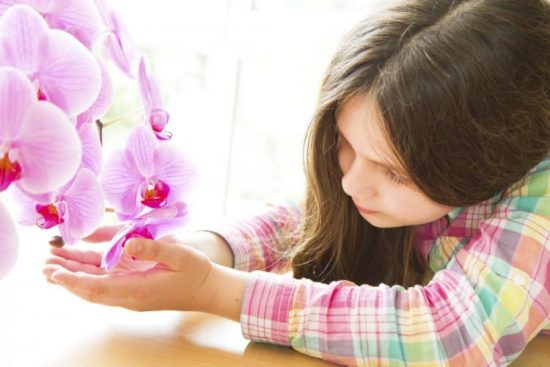Orchid Child is a term used to describe a child who will do poorly or exceptionally well, depending on that child’s environment. As you might have guessed, the term brings to mind the orchid flower: a flower that requires special care, but under ideal circumstances, grows to become a thing of phenomenal beauty. The good people of Sweden can be credited for coming up with the concept and the term (in Swedish: orkidebarn).
Just as the orchid child requires sensitivity and careful tending to thrive, the dandelion child (in Swedish: makrosbarn) will be hale and hearty no matter what is going on around him or how you treat him. He just bounces back. But the orchid child? If you don’t give that child the equivalent of hothouse care, her health is going to suffer. In fact, her very psyche is fragile and at risk.
Orchid Children Can Be Gifted
On the other hand, give that orchid child the treatment she needs and deserves and you’re going to end up with something very special. Maybe even prize-winning. Natch?
The term “orchid child” popped up in an otherwise dry scientific paper published in 2005, called Biological Sensitivity to Context. The paper’s authors, Bruce J. Ellis and W. Thomas Boyce, both human development specialists, studied children’s vulnerability to their family environments. Ellis and Boyce borrowed the Swedish neologism for describing a brand new concept in genetics and in child development: the idea that the neglected orchid child will fast wither, but with proper care, will not only live, but flourish.
The authors, scientists to the bone, found a need to resort to poetry to describe what happens when an orchid child gets what she needs, remarking that in such a case, the orchid child turns into “a flower of unusual delicacy and beauty.”
Orchid Child As New Idea
The work of Ellis and Boyce created a buzz within the small scientific circle of scientists who deal with both genetics and child development. Everyone knew about the resilient child and everyone knew that some kids are more vulnerable to stressful family situations. But here was something novel: the idea that the extra-sensitive child was not only vulnerable to stress, but capable of thriving under the right conditions. In fact, the orchid child, given the proper environment, can not only be hale and healthy, but develop exceptional gifts.
Ellis and Boyce had given birth to a new concept: the concept of the orchid child. Now that the idea had been invented and accepted, scientists had to figure out whether the orchid child was born that way: with a double-edged sword of sensitivity. Was this a genetic thing?
And so a search was born that continues to this day. Was there a gene or genes that created the orchid child? It seems so.
Orchid Child And Genes
Researchers began to look at genes linked to specific enzymes and brain chemical receptors, and what happens if you throw family chaos or abuse into the brew. The scientists saw that what you get is a whole bunch of mood disorders and behavioral issues. This is interesting because it means there may be genes that are associated with unpleasant lives.
This led one behavioral geneticist, Danielle M. Dick, to look at a gene known as CHRM2. Scientists have already found that many alcoholics possess this gene and they knew that alcoholism is part of a group of other behaviors including childhood conduct disorders and antisocial behavior. Not only that, but CHRM2 includes a chemical receptor that is linked to all sorts of brain functions like, for instance, learning and memory. Dick, along with 13 other researchers took DNA samples from 400 children already taking part in a larger study on child development.
Now these children had been studied since they were in kindergarten. But Dick and her colleagues came into the picture when the children were already 17 years old. The scientists looked at the CHRM2 gene in these children and also looked at the data on the children’s behavior. They looked to see who was delinquent, aggressive, involved in substance abuse, and so on. Then they talked to the kids and their parents.
CHRM2 Gene Variation
The scientists asked questions like: How much do your parents know about how you’re spending your free time? Do they know who your friends are? What do you buy with your pocket money?
From the answers, the scientists gradually developed a picture that showed some children were being carefully nurtured by their parents, while others were neglected. What they found was the orchid child or the child who had certain variations in their CHRM2 genes and had been either nurtured or neglected with predictable results.
Those orchid children who had caring, involved parents thrived. Those children whose parents had abused or neglected them typically became juvenile delinquents capable of the worst sorts of behavior and aggression. Another way of saying this is that kids at high risk for developing bad behaviors don’t have to fight so hard to stay normal, nice, and sane when raised in healthy, happy homes.
Orchid Children And Delinquency
Are you thinking you knew that all along? Don’t be so sure. As you might have suspected, the kids who became delinquents due to parental neglect or abuse mostly came from low-income neighborhoods.
But it’s equally true that if you put a dandelion child in this very same environment, he’s going to be just fine. The dandelion child is not susceptible to neglect, abuse, or poverty. He bounces back no matter what. And he doesn’t have that CHRM2 gene that makes him vulnerable to stress.
What are we supposed to learn from this study? Even a sensitive orchid child can do well–even better than the dandelion child–when given the support she needs at home. That’s even if she doesn’t live in the best neighborhood.
But a sensitive child growing up in a chaotic home is going to flounder.
And that’s a darned shame.
